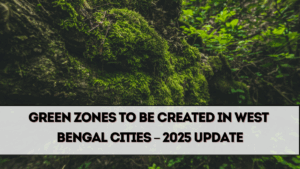Urbanization in India has brought rapid growth but also severe environmental challenges. Cities in West Bengal, like Kolkata, Asansol, and Siliguri, face rising pollution levels due to vehicular emissions, industrial activities, and shrinking green cover. To combat these issues, the state government has launched the Green Zone Planning WB 2025 initiative. This program focuses on creating dedicated green zones in urban areas to improve air quality, promote sustainability, and enhance the quality of life for residents.

Why Green Zones Are Important
Green zones are specially designated areas within cities where pollution control measures are strictly enforced. These zones prioritize eco-friendly practices, restrict heavy traffic, and increase tree plantation. The benefits include:
-
Improved Air Quality: Reduction of pollutants like PM2.5 and carbon emissions.
-
Public Health Protection: Lower rates of respiratory illnesses and stress.
-
Climate Resilience: Reduced heat island effects in cities.
-
Enhanced Biodiversity: More parks and green belts supporting local ecosystems.
-
Better Urban Living: Recreational spaces for residents.
Given the alarming pollution levels in several urban centers, the 2025 update makes green zone planning an urgent necessity.
Key Features of the Green Zone Planning WB 2025
The initiative has introduced clear guidelines for municipalities to establish and maintain green zones. Some highlights include:
-
Traffic Restrictions: Limiting heavy vehicles and high-emission cars in green zones.
-
Public Transport Focus: Expansion of eco-friendly buses and metro connectivity.
-
Mandatory Tree Plantation: Development of green belts and parks in designated areas.
-
Industrial Relocation: Relocating polluting industries outside residential zones.
-
Smart Air Monitoring: Installation of digital air quality sensors to monitor pollution levels.
-
Community Participation: Local residents and NGOs encouraged to maintain parks and gardens.
These features ensure that green zones become long-term sustainable spaces rather than short-term projects.
Cities Prioritized in the 2025 Update
The pollution control measures under this initiative are being implemented in phases. In 2025, the following cities are being prioritized:
-
Kolkata: Creation of green belts along Eastern Metropolitan Bypass and riverfront areas.
-
Asansol: Setting up eco-parks and restricting industrial pollution in residential areas.
-
Durgapur: Development of smart green corridors near schools and hospitals.
-
Siliguri: Expansion of tea garden green belts into urban peripheries.
-
Howrah: Riverbank restoration projects and park development to reduce pollution.
Each city’s green zone plan is tailored to its unique geography and urban challenges.
Benefits for Citizens
The initiative brings several direct benefits for residents:
-
Cleaner Environment: Noticeable reduction in dust, smoke, and air toxins.
-
Health Improvement: Fewer cases of asthma and lung-related diseases.
-
Recreational Spaces: Families gain access to cleaner parks and open spaces.
-
Property Value Increase: Homes near green zones often see higher market demand.
-
Cultural Revitalization: Eco-parks and riverfronts double up as cultural activity centers.
For urban populations struggling with congestion and pollution, these green zones will bring much-needed relief.
Government and Municipal Responsibilities
The success of Green Zone Planning WB 2025 lies in coordinated governance. Municipalities have been instructed to:
-
Identify potential areas for green zones.
-
Partner with environmental experts and NGOs.
-
Allocate budgets specifically for pollution control.
-
Enforce restrictions on vehicular and industrial emissions.
-
Conduct regular public awareness campaigns.
The state government will monitor progress through digital dashboards and quarterly reports.
Challenges in Implementation
Despite the promise, the initiative faces hurdles such as:
-
Resistance from industries reluctant to relocate.
-
Lack of public cooperation in waste segregation and traffic discipline.
-
High costs for setting up eco-friendly infrastructure.
-
Encroachment issues in urban parks and green spaces.
To address these, the government has planned strict enforcement laws and incentives for industries and citizens who support the green initiative.
Future of Green Zone Development in West Bengal
Looking ahead, the government envisions expanding green zones across all urban centers by 2030. Future goals include:
-
Eco-Friendly Transport: Complete electrification of public buses in major cities.
-
Urban Forests: Large-scale plantation drives to create urban mini-forests.
-
Green Certification for Cities: Awards for municipalities achieving pollution-free targets.
-
Sustainable Housing: Encouraging green building designs and rooftop gardens.
These steps will ensure that urban development aligns with environmental sustainability, making West Bengal a model for other states.
FAQs
What is the Green Zone Planning WB 2025 initiative?
It is a government program to create pollution-free urban spaces through traffic restrictions, tree plantations, and eco-friendly infrastructure.
Which cities are included in the first phase of green zone planning?
Kolkata, Asansol, Durgapur, Siliguri, and Howrah are being prioritized in the 2025 phase.
How will pollution control be monitored in green zones?
Smart air quality sensors and digital dashboards will track pollution levels in real time.
What benefits do citizens get from green zones?
Cleaner air, improved health, recreational spaces, and increased property values are key benefits for residents.
Click here to know more.
